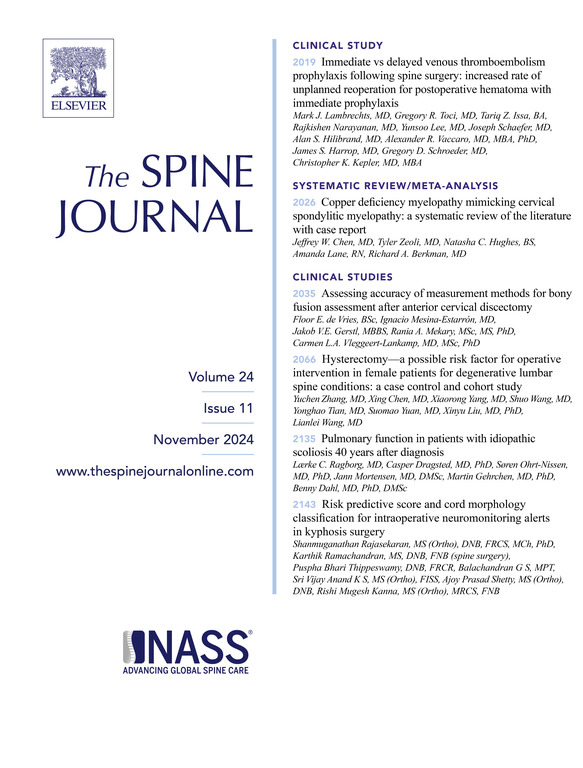Impact of rod placement and tulip design on screw-rod gripping capacity in spinopelvic fixation: evaluation across a spectrum of recessed to extended lengths
IF 4.7
1区 医学
Q1 CLINICAL NEUROLOGY
引用次数: 0
Abstract
Background Context
High rates of pelvic instrumentation failure (4.5%–38%) have been reported, often attributed to issues within the screw-tulip-rod connection. While previous research has explored various aspects of this connection, the influence of tulip design and relative rod placement on mechanical failure remains unclear.
Purpose
This study aims to investigate how screw-tulip design and variations in rod placement relative to the tulip affect the integrity of the screw-tulip-rod connection, utilizing axial and torsional gripping capacity tests to evaluate mechanical stability.
Study Design/Setting
Biomechanical.
Methods
Mechanical testing was conducted following ASTM F1798-21 to assess the interconnection mechanisms in pelvic fixation constructs. Using 5.5 mm Cobalt Chromium rods with porous fusion/fixation (PFFS) screws, axial gripping capacity (AGC) tests measured the axial load before translatory slippage of the rod, while torsional gripping capacity (TGC) tests assessed the torque required to induce rotational slippage. Variations in rod placement at the tulip head were tested in recessed (–2 mm, –1 mm), flush (0mm), and extended positions (+1 mm, +10 mm), simulating failure during flexion, extension, and rotation for both open and closed tulip-head designs. ANOVA was used to evaluate the effects of rod placement on connection failure, with significance set at p<.05.
Results
AGC and TGC tests revealed significant reductions for recessed rod placements, indicating suboptimal placement. At –1 mm and –2 mm, AGC for simulated flexion decreased by 28.8% (p<.010) and 45.6% (p<.001) for the open-head design and 30.5% (p<.018) and 57.5% (p<.001) for the closed-head design, respectively, compared to the nonrecessed rod placement. TGC also showed a significant decline at –2 mm, with a 25.4% reduction compared to the +1 mm extended length (p<.001) and a 20.3% reduction compared to the –1 mm recessed length (p=.005), irrespective of head design. The open and closed-head designs exhibited similar trends; however, the closed-head design was shown to better resist structural failure at recessed lengths. At –2 mm simulating extension, the closed-head design was 54.8% greater than the open-head design for AGC (p<.001) and 28.3% greater for TGC.
Conclusion
Our findings underscore that both flush (0mm) and extended (+1, +10 mm) rod placements relative to the screw-tulip offer sufficient gripping capacity whereas recessed placements (-1, -2 mm) have substantial reductions. The closed-head design was shown to better resist structural failure at recessed placements.
Clinical Significance
Rod placement relative to the most distal pelvic screw during spinopelvic fixation varries in surgical practice - whether flush to, extended past, or recessed into the screw-head. Biomechanical evaluating of the axial and torsion gripping capacities at these positions provides a foundation for clinical decision-making.
螺钉杆放置和郁金香设计对脊柱-骨盆固定中螺钉杆夹持能力的影响:从内嵌到延长长度的评估。
背景背景:据报道,骨盆内固定失败率很高(4.5-38%),通常归因于螺钉-郁金香棒连接的问题。虽然以前的研究已经探索了这种联系的各个方面,但郁金香设计和相对杆放置对机械故障的影响仍不清楚。目的:本研究旨在探讨螺旋-郁金香设计和杆相对于郁金香放置的变化如何影响螺旋-郁金香-杆连接的完整性,利用轴向和扭转握持能力测试来评估机械稳定性。研究设计/设置:生物力学方法:按照ASTM F1798-21进行力学测试,以评估骨盆固定装置的连接机制。使用5.5mm钴铬棒和多孔融合/固定(PFFS)螺钉,轴向夹持能力(AGC)测试测量了杆发生平移滑移前的轴向载荷,而扭转夹持能力(TGC)测试评估了引起旋转滑移所需的扭矩。测试了插杆在郁金香头位置的变化,包括凹槽(-2mm、-1mm)、平直(0mm)和延伸位置(+1mm、+10mm),模拟了开放和关闭郁金香头设计在弯曲、延伸和旋转过程中的故障。方差分析用于评估杆放置对连接失败的影响,结果显著性设置为:AGC和TGC测试显示,嵌入式杆放置显著减少,表明次优放置。在-1mm和-2mm时,模拟屈曲的AGC降低了28.8%(结论:我们的研究结果强调,相对于螺旋郁金香,平直杆(0mm)和延伸杆(+1,+10mm)的放置都提供了足够的抓握能力,而凹置杆(-1,-2mm)的放置有显著的降低。封闭封头设计可以更好地抵抗凹陷位置的结构破坏。临床意义:在脊柱-骨盆固定过程中,相对于最远端的骨盆螺钉,棒的放置位置在手术实践中是不同的-无论是与螺钉头平直,延伸过去还是嵌入螺钉头。在这些位置进行轴向和扭转抓握能力的生物力学评估为临床决策提供了基础。
本文章由计算机程序翻译,如有差异,请以英文原文为准。
求助全文
约1分钟内获得全文
求助全文
来源期刊

Spine Journal
医学-临床神经学
CiteScore
8.20
自引率
6.70%
发文量
680
审稿时长
13.1 weeks
期刊介绍:
The Spine Journal, the official journal of the North American Spine Society, is an international and multidisciplinary journal that publishes original, peer-reviewed articles on research and treatment related to the spine and spine care, including basic science and clinical investigations. It is a condition of publication that manuscripts submitted to The Spine Journal have not been published, and will not be simultaneously submitted or published elsewhere. The Spine Journal also publishes major reviews of specific topics by acknowledged authorities, technical notes, teaching editorials, and other special features, Letters to the Editor-in-Chief are encouraged.
 求助内容:
求助内容: 应助结果提醒方式:
应助结果提醒方式:


